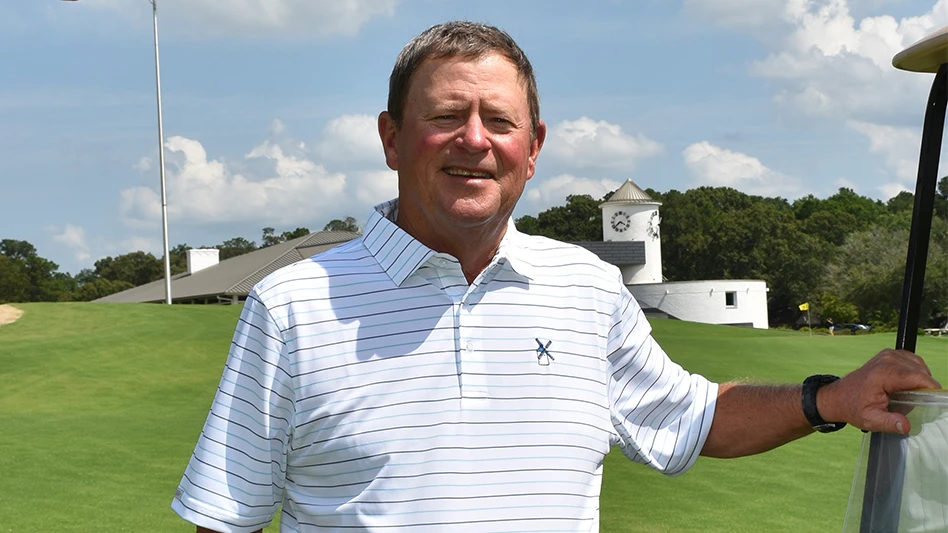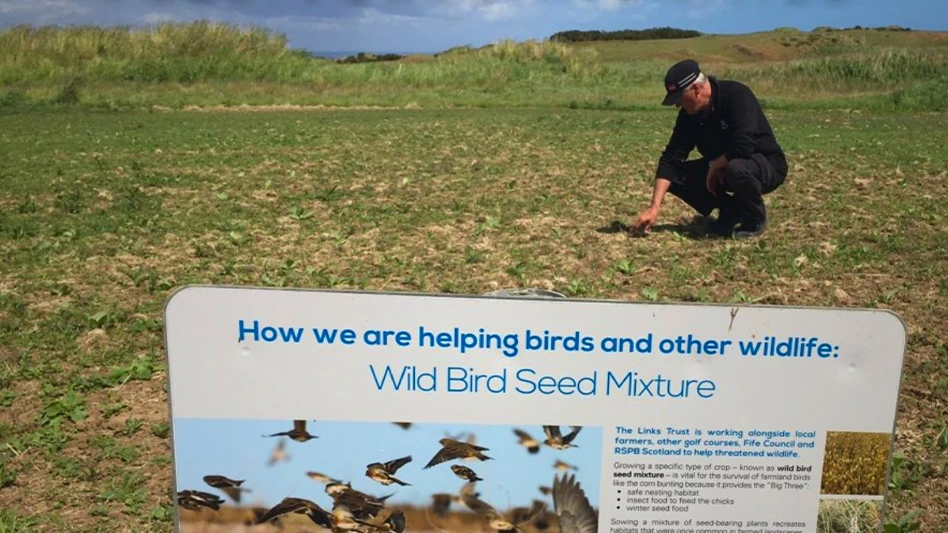 Eagle Golf Construction turned a former dumping ground into the gem of a community and a golf course worthy of professional tournament play.
Eagle Golf Construction turned a former dumping ground into the gem of a community and a golf course worthy of professional tournament play.
Garbage. Slag. Industrial waste.
These are generally not the kinds of things you find on a golf course. Nor do you find drug dealers and prostitutes roaming about. But they were all present at the site of The Golf Club at Harbor Shores before it became a golf course so impressive it was named to host the 2012 and 2014 U.S. Senior PGA Championship.
"I would say that this was one of the greatest achievements of my life – next to the birth of my little girl," says E. Randal Pichan, president of Eagle Golf Construction.
Consider the challenges Pichan and his team faced: clean-up and restoration of the 540-acre "Brownfield Site," remediating poor soil conditions, dealing with permit and approval delays, working around endangered dunes plants, constructing a 13-mile piping system to collect the site's drainage run-off and fighting off a park preservation society that opposed the project.
 Washouts were covered with sod grown in nurseries on the driving range tees. Washouts were covered with sod grown in nurseries on the driving range tees. |
Even though a park on the site had become a haven for pushers, some folks felt that it had historical significance given that it had been donated by an important local family in the early 1900s. Ultimately, golf won out and the parking lot became one of the course's holes. But Bob McFeeter of Evergreen Development Company restored the old park to an exact replica of what it used to be, and people started coming back to it.
Pichan recalls one elderly man he talked to who appeared lost while visiting the site.
"He said that he had been hearing about the project and that he and his wife had frequented the park back in the 1950s and had enjoyed the beach and the waterfront but had not been back since," says Pichan. "But he said to see what we had done reminded him of old times once again. So it was really good to hear from someone who appreciated our efforts."
Local businesspeople also appreciated the radical makeover. One family that had owned the North Shore Inn restaurant – which Pichan says has the best burger in town – since the 1960s and kept the business open even through the bad times was thoroughly elated at seeing the area brought back to its former glory.
"In the early '60s, factories lined the area, and they had beautifully manicured flower beds and lawns," says Pichan. "The family said what we did with the course reminded them of that time when things were gorgeously landscaped."
The public will now be able to take advantage of walking trails throughout the course and canoe or kayak down a river they never could before. The ultimate goal was to create a first-class resort course that would help revitalize a depressed and downtrodden community that had been in economic and social decline for more than 40 years.
Judging by the number of homes being built in the new development, which Pichan says are going up "left and right," the project achieved that goal. But perhaps more important than the homes and the pure aesthetic beauty of their creation is the hard dollars they'll give to three non-profit organizations: Cornerstone Alliance, an economic development entity; the Whirlpool Foundation, whose namesake company owned the property and a consortium of church and community welfare groups called The Alliance. They will receive $30,000 annually, plus $5,000 or 20 percent of annual net operating income – whichever is greater. The remaining 80 percent will go toward Community Benefits programming.
To get an idea of the amount of waste that existed on the site at the onset of the project, consider that 110,000 cubic yards of garbage and more than 5,000 tires were removed and properly disposed of at the local dump. Foundry waste was used beneath large fills in the mounding along 10 of the 18 holes. Most important was the eight to 12 inches of capping sand – 130,000 cubic yards – that was used over the entire course to seal off all the contaminants and protect golfers, a requirement of the EPA.
Pichan could not praise superintendent Brad Fry more for his finish work and grassing, calling him "one of the finest grow-in superintendents in the country."
"I've never seen someone go after a course so aggressively, and it really made us shine," says Pichan. "He didn't wait – he jumped and attacked the washouts. He approached the job like a linebacker going after a running back. He just had a 'get the job done,' no-holds barred attitude."
The washouts were replaced with sod from other parts of the course Fry knew he could grow back in. Two tees on the west end of the driving range were used and a tee on the east end was used as a nursery. It was replanted three to four times, with Fry stripping it off to use on fairways or tees or other areas that were deficient.
 The construction process was so long that Fry had to maintain new turfgrasses through two winters. A blend of A1 and A4 bentgrasses were chosen for the greens, Dominant Plus bentgrass for tees and fairways, Kentucky bluegrass/fine fescue blend for playable roughs and a straight fine fescue mix for unplayable roughs. Entering the winter season, Fry's crews mowed the greens, then covered some of them. He was able to mow 90 percent of the tees and fairways before winter, while the rest were treated with snow-mold applications.
The construction process was so long that Fry had to maintain new turfgrasses through two winters. A blend of A1 and A4 bentgrasses were chosen for the greens, Dominant Plus bentgrass for tees and fairways, Kentucky bluegrass/fine fescue blend for playable roughs and a straight fine fescue mix for unplayable roughs. Entering the winter season, Fry's crews mowed the greens, then covered some of them. He was able to mow 90 percent of the tees and fairways before winter, while the rest were treated with snow-mold applications.
Fry said the wind was extremely challenging when seeding.
"To combat the wind, we hydroseeded and used soil erosion blankets," he says. "Working on the holes that were right next to Lake Michigan was extremely difficult."
Working with the Jack Nicklaus Design team and associate Chris Rule was not intimidating, Fry says, but rather rewarding.
"I've worked with them before, so there was no intimidation factor there," he says. "If anything, it was exciting."
Pichan lauded Nicklaus Design as well.
"Having Nicklaus attached to the project drove it and made things happen," he says. "He's the best, until he gets dethroned. He's just a superb man, and he made things happen where other people cannot or have a hard time doing it."
Nicklaus Design's Chris Rule returned praise to Eagle Construction, "There were an extreme amount of construction challenges, and Eagle Golf stayed the course and was an integral part of creating a special golf course," he says.
Irrigation of the course was one of the challenges, particularly finding a suitable water source. According to Mike Kuhn, the irrigation consultant who worked on the project, southeastern and southwestern Michigan have issues with high salt content in the groundwater. Creating irrigation ponds was out of the question because there wasn't enough acreage. The ponds they did excavate were unsuitable due to the soil quality and not knowing how it might affect the water. So they ended up pumping water directly from the Paw Paw River.
"It was one of the hardest tasks we had," says Kuhn. "Getting the necessary permits took the better part of a year, and we also had issues with zebra mussels, which forced us to take preventative measures to keep them out."
The irrigation pump station is a vertical turbine variable speed prefabricated system capable of pumping 1,800 gallons per minute at 120 lbs. per square inch of pressure. The submerged intake is screened and positioned in order to prevent fish, including young sturgeon, vegetation and sediment from entering the intake line. The design process for the intake pipe, says Kuhn, took a long time and lots of engineering.
"Typical velocities in our intake are one to three feet per second," Kuhn explains. "For this one, we used a 26-inch high density polyethylene intake pipe that we had to drill a series of holes in, and the holes had to be a certain size and spaced out a certain distance to keep our velocities under .25 feet per second so as to not to draw in any fish, even young fish."
 The team embraced the environmental challenges of the native plants, naming the holes after them and posting helpful information for players in the golf carts. The team embraced the environmental challenges of the native plants, naming the holes after them and posting helpful information for players in the golf carts. |
The state-of-the-art, fully-automated irrigation system consists of 1,606 sprinklers, electrically-activated control valves and a controller and central control system that minimizes overwatering. Eighty acres of turfgrass are irrigated, while 130 acres of fine fescue unmaintained areas are not.
Each hole was named after a native plant growing on it: For example, No. 1 hole is named Aster and the hole at No. 2 is named Rose Pink. Rose-pink, in addition to wild sweet potato and swamp rose mallow, were species that the State of Michigan was particularly concerned about.
Certain areas on each hole were highlighted with selective clearing, additional plantings and continued maintenance to draw more attention from golfers to the native plant species. Literature is posted in every golf cart to notify golfers of environmentally-sensitive areas. Plus, as part of his greeting, the starter explains where these areas are to golfers as well.
And what better way to officially open the course than with a skins game between legends Nicklaus, Arnold Palmer, Tom Watson and Johnny Miller – with the highlight being $3 million donated by the golfers and the Whirlpool Foundation to the Boys and Girls Clubs of America.

Explore the September 2011 Issue
Check out more from this issue and find your next story to read.
Latest from Golf Course Industry
- Making the grade — at or near grade
- PBI-Gordon receives local business honor
- Florida's Windsor takes environmental step
- GCSAA names Grassroots Ambassador Leadership Award winners
- Turf & Soil Diagnostics promotes Duane Otto to president
- Reel Turf Techs: Ben Herberger
- Brian Costello elected ASGCA president
- The Aquatrols Company story





